标签:des style blog http color os io ar strong
A processing core comprising instruction execution logic circuitry and register space. The register space to be loaded from a?VMCS, commensurate with a VM entry, with information indicating whether a service provided by the processing core on behalf of the VMM is enabled. The instruction execution logic to, in response to guest software invoking an instruction: refer to the register space to confirm that the service has been enabled, and, refer to second register space or memory space to fetch input parameters for said service written by said guest software.
The field of invention is related to virtualization generally and CPU supported services for VM guest software specifically.
Many present day computing systems implement "virtualization". A typical implementation is illustrated in?FIG. 1. As observed in?FIG. 1, a layer of software102?is imposed between the operating system?101?software and the CPU?103. This layer of software?102?typically includes one or more virtual machines (VMs)?102?a_1-102?a_N that "run on top" of a virtual machine monitor (VMM)?102?b. Although not a strict requirement,?FIG. 1?shows a common arrangement where different software application instances?100_1-100_N are each provided with its own operating system instance?101_1?-101_N that runs on top of a dedicated virtual machine?102a_1-102?a_N.
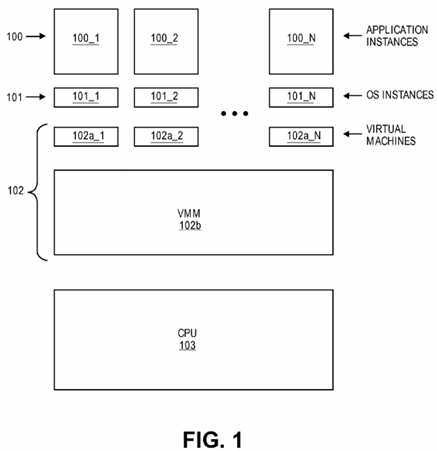
A VM presents the appearance of a CPU to the software that runs on it; such software is often known as "guest" software. As a consequence, at least as a first approximation, the software running on the virtual machine may "think" that it has the resources of an entire computer system to itself. The VMM?102?b?is responsible for supporting multiple VMs on an underlying CPU?103. As such, the VMM?102?b?coordinates the concurrent requests/needs of the multiple VMs on the CPU103. This includes correlating allocations of actual resources of the underlying computing system (e.g., CPU threads, system memory space, disk drive storage space, etc.) to the "virtual" computing system resources that the software running on the VMs refer to.
While guest software normally "thinks" that it running on its own computer system with no VMM, it is also possible for such software to be designed to know when it is running in a VM supported by a VMM. Such software is sometimes called "paravirtualized" or "enlightened." Software that "knows" it is running on a VMM (e.g., in one of the VMs?102?a_1-102?a_N) may be designed to directly invoke certain "services" provided by the VMM?102?b.?Presently, however, in order to invoke a VMM service, control of the CPU must first pass to the VMM from the VM in which the application/OS instance making the invocation is running; this control transfer is sometimes referred to as a "VM exit". One possible consequence of a VM exit is that the CPU must "switch" its active context or state from that of the VM‘s process to that of a VMM process. After the service has been completed, the CPU must again switch its active context/state back from the VMM process to the VM process; this return control transfer is sometimes referred to as a "VM entry."
FIG. 2?shows a prior art process for invoking a VMM service. As observed in?FIG. 2, an application/OS instance recognizes a need to invoke a VMM service?201. Prior to the invocation, the application/OS instance may populate?202?registers and/or memory with values that identify the specific service being invoked and the service‘s input parameters. To then invoke the VMM service, the application/OS instance executes an instruction?203?for invoking the VMM service. For example, in the case of present day Intel processors having VT-x technology, the application/OS instance executes the VMCALL instruction, which was designed for calling the VMM explicitly from a process that is being run on a VM. (The application/OS instance might instead use another instruction, such as CPUID or WRMSR, that causes VM exits and that the VMM has enabled for this purpose.)
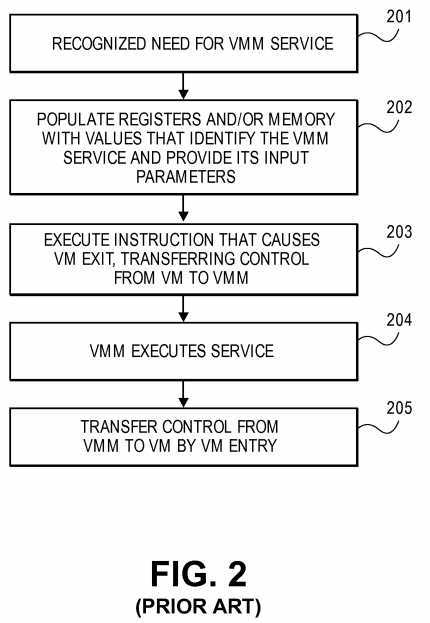
In response to the VMCALL instruction being executed, control of the CPU is transferred from the VM to the VMM?203?(VM exit). In operation, microcode within the CPU implements the aforementioned context/state switching by moving the context/state information of the VM from software visible CPU register space to the Virtual-Machine Control Structure (VMCS), which has been configured by the VMM, and reloading much of these same software visible registers with context/state information for the VMM process from elsewhere in the?VMCS.
The VMM process refers to the memory or register values established by the invoking application/OS instance to understand what service is being requested and to accesses the service‘s input parameters. The VMM process then executes the service?204. This is accomplished by executing VMM program code written to perform the service.
After the service is completed, control transfers back from the VMM to the VM by way of a VM entry?205. Here, CPU microcode loads the VM context/state from the?VMCS?into the software visible register space.
An example of a VMM service is a "guest address space switching" service. This service may be useful to guest software running in virtual machines for which a VMM supports multiple address spaces, as explained in the following paragraphs.
A VMM typically supports, for each of its VMs, a "guest address space". This is a mapping from the addresses that the guest "thinks" are physical (guest-physical addresses) to true physical addresses that can be used to access memory; the mapping may also specify access rights (e.g., read/write, read-only, etc.) for each guest-physical address. In the case of present day Intel processors having VT-x technology, guest address spaces may be implemented using extended page tables (EPT).
In the absence of paravirtualization, a VMM will typically support a single guest address space per VM. If guest software is paravirtualized, a VMM may establish multiple guest address spaces for a single VM, although only one will be active at a time. In one example, these address spaces may differ from each other with regard to how different regions of memory are protected. There might be a different guest address space for each application module running in the VM; the guest address space for a module might allow the module to access its own memory but not the memory belonging to other modules.
For a VM supported by multiple guest address spaces, the VMM will need to change which guest address space is active when appropriate. An efficient mechanism is for guest software to inform the VMM when to change the guest address space (e.g., when the guest OS is changing from one application module to another). Guest software can inform the VMM via a "guest address space switching" service.
As noted earlier, the VMCALL or other instruction can be executed to call the VMM for the guest address space switching service. Prior to execution of the instruction, the guest software may place a value in a register (e.g., an EAX register) or memory to identify the "guest address space switching" service. An identifier of the address space to be switched to may be specified in an additional register (e.g., the EBX register) or in memory. The instruction causes a VM exit, and the service is performed as described above by the VMM.
The present invention is illustrated by way of example and not limitation in the figures of the accompanying drawings, in which like references indicate similar elements and in which:
FIG. 1?shows a virtualization scheme (prior art);
FIG. 2?shows a process for invoking a VMM service from guest software (prior art);
FIG. 3?shows a process for invoking a CPU provided service from guest software;
FIG. 4A?shows a CPU provided guest address switching service system;
FIG.?4AB shows a CPU provided guest address switching service method;
FIG. 5?shows an embodiment of a processor;
FIG. 6?shows an embodiment of a computing system.
The fact that a VM exit occurs every time guest software invokes a VMM service corresponds to a form of inefficiency. Specifically, as described above, significant register content movement needs to take placed between software visible register space and the?VMCS?in order to switch the context/state of the program flow from that of the VM to that of the VMM.
One way to avoid a VM exit is to embed the functionality of the service in the CPU rather than in the VMM. Here, because the CPU rather than the VMM is performing the requested service, no transfer of control or context switching within the CPU to is required. In various embodiment, although the VMM no longer performs the service, the service is configured by the VMM. In an embodiment, guest software invokes the service via a specific instruction. This may be one of some number of existing instructions that are redefined to invoke the service by the CPU, or it may one of some number of new instructions specifically defined to support VMM-configured services. The immediately following discussion of?FIG. 3?discusses an embodiment in which this new approach is implemented with a single new instruction, VMFUNC, which is built into the instruction set of the CPU.
FIG. 3?shows a process flow for the configuration and use of a VMFUNC instruction. As observed in the process of?FIG. 3, during an initial configuration for a specific instance of guest software or a VM, the VMM indicates?301?(e.g., by writing into the VM‘s?VMCS) whether VMFUNC is enabled for the guest software/VM, and, if so, which particular CPU provided services are enabled for the guest software instance/VM. The next VM entry?302?loads this configuration information from the?VMCS?into the CPU‘s private control register space (i.e., space not visible to guest software). For simplicity the discussion below is presented as if the configuration information kept in?VMCS?is specific to a particular instance of guest software, however, the reader should understand that this information may also be specific to a VM that guest software runs on.
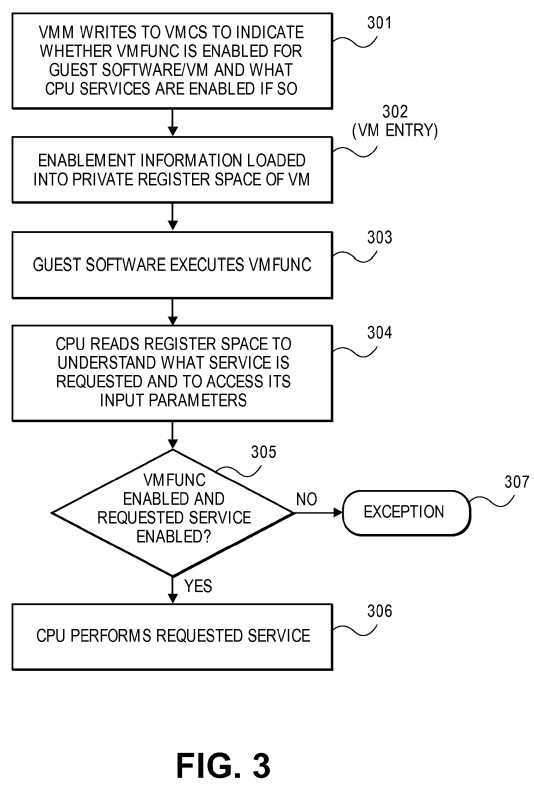
In this embodiment, guest software wishing to invoke a VMM configured service first loads the EAX register with a value that identifies the service it wishes to invoke. If appropriate, the guest software loads other registers (e.g., the EBX or ECX registers) with relevant information (e.g., input parameters) pertinent to that service. After these registers have been loaded, the guest software executes the VMFUNC instruction?303?to invoke the service.
Although the above discussion describes a process by which the enabling of each service for a VM is specified in the?VMCSand guest software identifies the desired service by writing to on die processor registers, the reader will understand that any such configuration information and/or guest software service invocation can be made alternatively or in combination through memory.
In response to the execution of the VMFUNC instruction, instruction execution logic within the CPU examines the information in the EAX register to understand what specific service is being requested and, if appropriate, other registers to obtain the applicable input information?304.
The instruction execution resources of the CPU then look?305?to the private control registers that were earlier loaded?302with?VMCS?information upon VM entry to see whether VMFUNC is enabled for the guest software and, if so, whether the specific service that has been requested by the guest software has also been enabled. If VMFUNC has not been enabled for the guest software, or, if VMFUNC has been enabled but the specific requested service has not been enabled, the CPU hardware raises an exception?307. If both VMFUNC and the requested service have been enabled, the CPU‘s instruction execution resources perform the service?306.
Some embodiments may limit some or all services to specific privilege levels or operating modes. Such embodiments may check the privilege level and/or operating mode before or after checking that VMFUNC and the requested service have been enabled. If the CPU is not operating at the proper privilege level and operating mode, the CPU may generate an exception or a VM exit.
When the VMFUNC instruction performs an invoked VMM configured service, all processing occurs without switching contexts between the VM process and a VMM process; this is in contrast to the prior-art approach of causing a VM exit using the VMCALL instruction (or other instructions that cause VM exits).
In an embodiment, the private register space for an instance of guest software (loaded from the?VMCS) includes an?EPTpage-table pointer-address that points to the?EPT?page-table hierarchy for address translations to be performed for the guest software that is running on the VM (i.e., for the current guest address space). Here, the translations in the?EPT?page-table hierarchy define the (potentially multi-step) translation process from physical addresses specified by the guest software ("guest-physical addresses") to the physical addresses in system memory where the data/instructions associated with the specified addresses actually reside, as well as the access rights with which guest software may access those physical addresses.
Different components of guest software (e.g., two different applications or two different software modules of a same application) may access different physical locations of system memory. A VMM may provide protections between those components by associating each such component with its own?EPT?page-table hierarchy. For example, if the guest software corresponds to an OS instance, the OS kernel can arrange to have different modules of the OS (including modules that are plugged into the OS such as drivers) operate from different memory address spaces, protecting each module from others within the same OS instance. For instance a driver may be configured to access one portion of physical memory and other modules of the OS instance, such as the OS kernel, could be configured to access a second portion of physical memory. By further making the OS kernel‘s memory space read-only, the OS kernel could be protected from other less trusted software modules (such as the driver).
Changing the?EPT?page-table pointer-address, kept in the private register space and in the?VMCS, changes which?EPTpage-table hierarchy, and therefore which translation scheme, is utilized for the VM‘s active guest software. According to one embodiment, the VMFUNC instruction is used to change the?EPT?page-table pointer-address without a VM exit. As program flow flows through the various software modules of the guest software, VMFUNC is executed on transitions between the software modules to setup their appropriate respective address spaces. For instance, when program flow flows from the OS kernel to the driver, VMFUNC is executed as part of the transition to set up the driver‘s address space. Likewise, when program flow flows back to the OS kernel from the driver, VMFUNC is again executed on the transition to switch back to the OS kernel‘s address space.
Recall at step?302?of?FIG. 3?that the private register space is loaded from?VMCS?by VM entry. In an embodiment, if a guest-address-space switching service is to be enabled for the guest software, an address in the?VMCS?that identifies a "table of pointers" is also loaded into the private register space from?VMCS. The table of pointers corresponds to the collection of different page table hierarchies that may be utilized from the guest software. In an embodiment the table of pointers is pre-configured by the VMM.
FIGS. 4?a?and?4?b?pertain to an embodiment of implementing a guest-address-switching service in CPU hardware.?FIG. 4?ais drawn from the perspective after which VM entry?430?has occurred and, as part of the VM entry process, private control register space?401,?402,?403?has been loaded by the CPU?430?with information from the?VMCS?404?that specifies the following: i) whether VMFUNC has been enabled?401; ii) whether guest address switching has been enabled?402; iii) the address?403?of the table of pointers?407; iv) a pointer?409?to an initial page table hierarchy A?410.
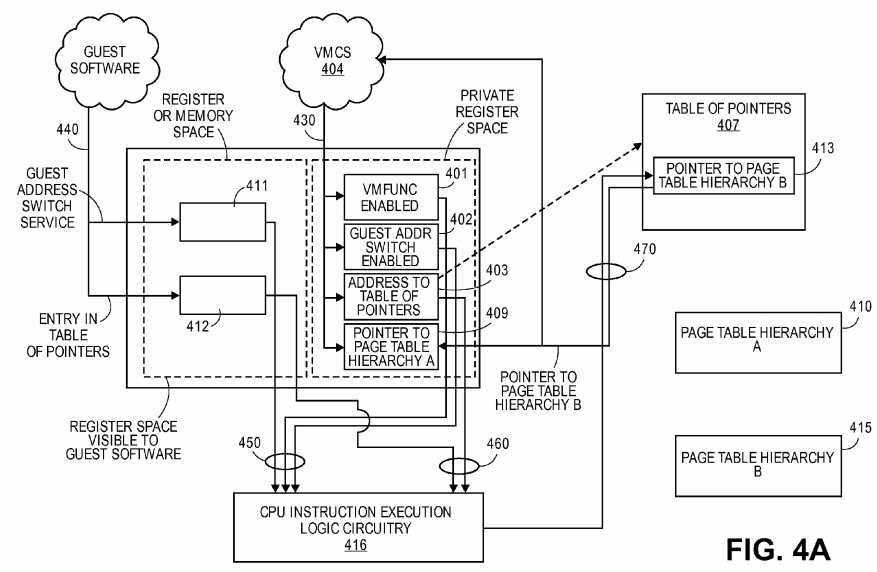
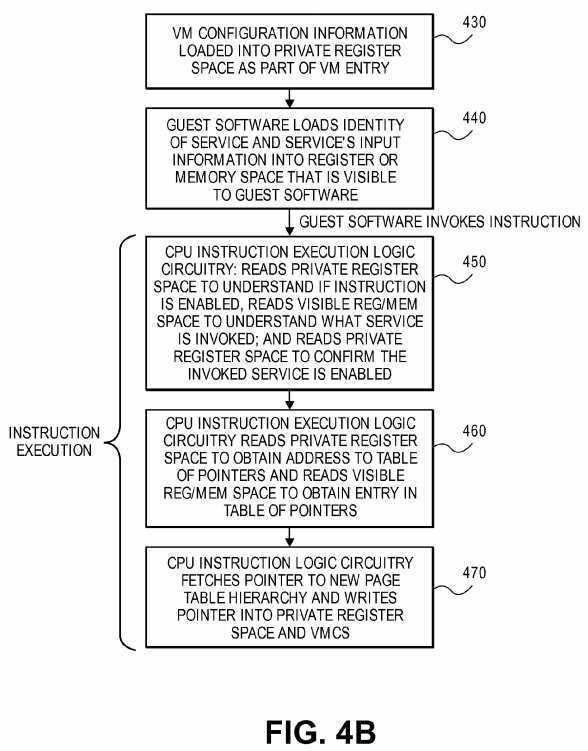
While the guest software is executing, the page-table pointer-address located in private register space?409?points to the page-table hierarchy?410?that includes the proper address translation information for the guest software. Subsequently, the guest software decides to execute the VMFUNC instruction to invoke the guest address switching service. In setting up the input parameters for the VMFUNC instruction?440, a location in memory or a register (in an embodiment, the EAX register411) is loaded with a value that identifies the guest address switching service and a second location in memory or register (in an embodiment, the ECX register?412) is loaded with a value that identifies an entry?413?in the table of pointers?407where the page-table pointer-address?414?for the address space being switched to (represented by page table hierarchy B415) is located.
In executing the instruction, CPU execution unit resources?416?first read?450?register/memory space?411?to understand that the guest-address-switching service is being invoked and private register space?401?and?402?to check whether VMFUNC has been enabled for the guest software and, if so, whether guest-address-switching has been enabled for the guest software. After confirmation that both VMFUNC and guest-address-space switching has been enabled, CPU execution unit resources?416?next read?460?register space?403?(the address of the table of pointers) and register/memory space?412(indicating a chosen entry in the table of pointers) to fetch a new page-table pointer-address?414?(at entry?413?in the table of pointers?407), load?470?it into register space?409, and store?470?it into register or memory space allocated to?VMCS 404. After the new page-table pointer-address is loaded, the translations for the guest software are now translated using page table hierarchy?415?rather than page table hierarchy?410?(that is, the guest address space has been switched).
Although the above discussion has been directed to a guest address switching service implemented in CPU hardware, other services provided by a VMM may also be integrated into the CPU. These include but are not limited to the following: 1) mapping or unmapping specific regions of memory with certain permissions; 2) processing a virtual interrupt in a specific way (e.g., defining operating characteristics of a virtual interrupt controller); 3) pinning memory to be used as I/O buffers. Note that items 1) and 3) above as well as the guest address space switching function all change a memory configuration.
FIG. 5?shows a generic processing core?500?that is believed to describe many different types of processing core architectures such as Complex Instruction Set (CISC), Reduced Instruction Set (RISC) and Very Long Instruction Word (VLIW). The generic processing core?500?of?FIG. 5?includes: 1) a fetch unit?503?that fetches instructions (e.g., from cache or memory); 2) a decode unit?504?that decodes instructions; 3) a schedule unit?505?that determines the timing and/or order of instruction issuance to the execution units?506?(notably the scheduler is optional); 4) execution units?506?that execute the instructions; 5) a retirement unit?507?that signifies successful completion of an instruction. Notably, the processing core may or may not include microcode?508, partially or wholly, to control the micro operations of the execution units?506. The instruction execution resources/logic referred to in preceding discussions may be implemented with one or more of the execution units within execution units?506.
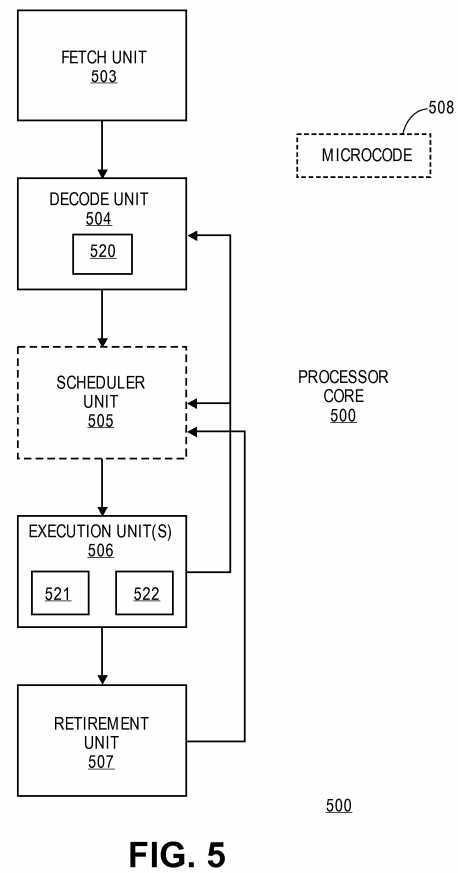
A processing core having the functionality described above can be implemented into various computing systems as well. FIG. 6?shows an embodiment of a computing system (e.g., a computer). The exemplary computing system of?FIG. 6 includes: 1) one or more processing cores?601?that may be designed to include two and three register scalar integer and vector instruction execution; 2) a memory control hub (MCH)?602; 3) a system memory?603?(of which different types exist such as DDR RAM, EDO RAM, etc,); 4) a cache?604; 5) an I/O control hub (ICH)?605; 6) a graphics processor?606; 7) a display/screen?607?(of which different types exist such as Cathode Ray Tube (CRT), flat panel, Thin Film Transistor (TFT), Liquid Crystal Display (LCD), DPL, etc.) one or more I/O devices?608.
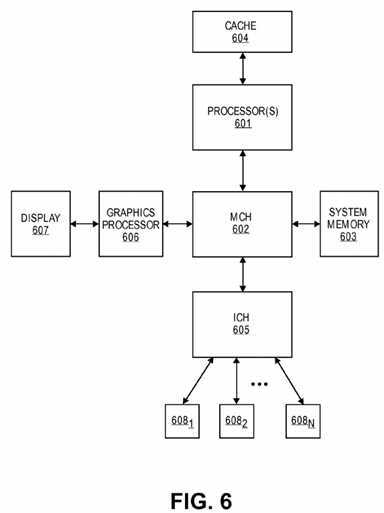
The one or more processing cores?601?execute instructions in order to perform whatever software routines the computing system implements. The instructions frequently involve some sort of operation performed upon data. Both data and instructions are stored in system memory?603?and cache?604. Cache?604?is typically designed to have shorter latency times than system memory?603. For example, cache?604?might be integrated onto the same silicon chip(s) as the processor(s) and/or constructed with faster SRAM cells whilst system memory?603?might be constructed with slower DRAM cells. By tending to store more frequently used instructions and data in the cache?604?as opposed to the system memory?603, the overall performance efficiency of the computing system improves.
System memory?603?is deliberately made available to other components within the computing system. For example, the data received from various interfaces to the computing system (e.g., keyboard and mouse, printer port, LAN port, modem port, etc.) or retrieved from an internal storage element of the computing system (e.g., hard disk drive) are often temporarily queued into system memory?603?prior to their being operated upon by the one or more processor(s)?601?in the implementation of a software program. Similarly, data that a software program determines should be sent from the computing system to an outside entity through one of the computing system interfaces, or stored into an internal storage element, is often temporarily queued in system memory?603?prior to its being transmitted or stored.
The ICH?605?is responsible for ensuring that such data is properly passed between the system memory?603?and its appropriate corresponding computing system interface (and internal storage device if the computing system is so designed). The MCH?602?is responsible for managing the various contending requests for system memory?603?access amongst the processor(s)?601, interfaces and internal storage elements that may proximately arise in time with respect to one another.
One or more I/O devices?608?are also implemented in a typical computing system. I/O devices generally are responsible for transferring data to and/or from the computing system (e.g., a networking adapter); or, for large scale non-volatile storage within the computing system (e.g., hard disk drive). ICH?605?has bi-directional point-to-point links between itself and the observed I/O devices?608.
SRC=https://www.google.com.hk/patents/US20140013326
Instruction-Set Support for Invocation of VMM-Configured Services without VMM Intervention
标签:des style blog http color os io ar strong
原文地址:http://www.cnblogs.com/coryxie/p/3960178.html